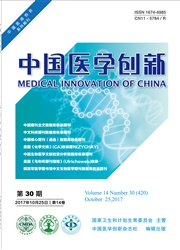

 中文摘要:
中文摘要:
目的:研究血清IL-6及IL-12水平在骨肉瘤患者与健康体检者之间的差异及临床意义。方法:采用酶联免疫吸附法(ELISA)检测160例骨肉瘤患者及250例健康体检者的外周血血清IL-6及IL-12水平,比较两组间IL-6、IL-12水平的差异及其相关性,探讨血清IL-6及IL-12水平与骨肉瘤发病及进展的关系。结果:骨肉瘤组患者血清IL-6水平明显高于对照组(P〈0.01),IL-12水平明显低于对照组(P〈0.01)。在骨肉瘤患者中,处于肿瘤发病Ⅲ~Ⅳ期的患者其血清IL-12水平低于Ⅰ~Ⅱ期患者(P〈0.05);合并远处转移的患者血清IL-12水平低于不发生远处转移的患者(P〈0.05)。血清IL-6水平与IL-12水平无明显线性相关(P〉0.05)。结论:血清IL-6及IL-12水平在骨肉瘤患者表达异常,两者在骨肉瘤的发生中可能起免疫调节作用,IL-12的低表达可能与骨肉瘤的进展相关。
 英文摘要:
英文摘要:
Objective:To explore the difference of serum IL-6 and IL-12 levels between the patients with osteosarcoma and healthy individuals,as well as its clinical signifcance.Method:By ELISA,the concentration of serum IL-6 and IL-12 levels were measured in 160 patients with osteosarcoma(osteosarcoma group) and 250 healthy individuals (controls group).Differences between serum IL-6 and IL-12 levels were compared and analyzed its correlation.The relationship between serum IL-6 and IL-12 levels and the incidence and progression of osteosarcoma were investigated.Result:The levels of serum IL-6 was significantly higher in the osteosarcoma group than in the control group(P〈0.01),the level of serum IL-12 was significantly lower in the case group than in the controls group (P〈0.01).Serum IL-12 levels in stages Ⅲ-Ⅳ were lower than those in stages Ⅰ-Ⅱ of osteosarcoma (P〈0.05).Patients with metastasis had higher IL-12 levels than those without metastasis (P〈0.05). No associations were found between IL-6 and IL-12 levels(P〉0.05).Conclusion:This study indicates that serum IL-6 and IL-12 levels abnormal expression in osteosarcoma patients. IL-6 and IL-12 may play the role of immunoregulation in the pathogenesis of osteosarcoma,the lower serum IL-12 levels may be associated with development and progression of osteosarcoma.
 同期刊论文项目
同期刊论文项目
 同项目期刊论文
同项目期刊论文
 期刊信息
期刊信息
